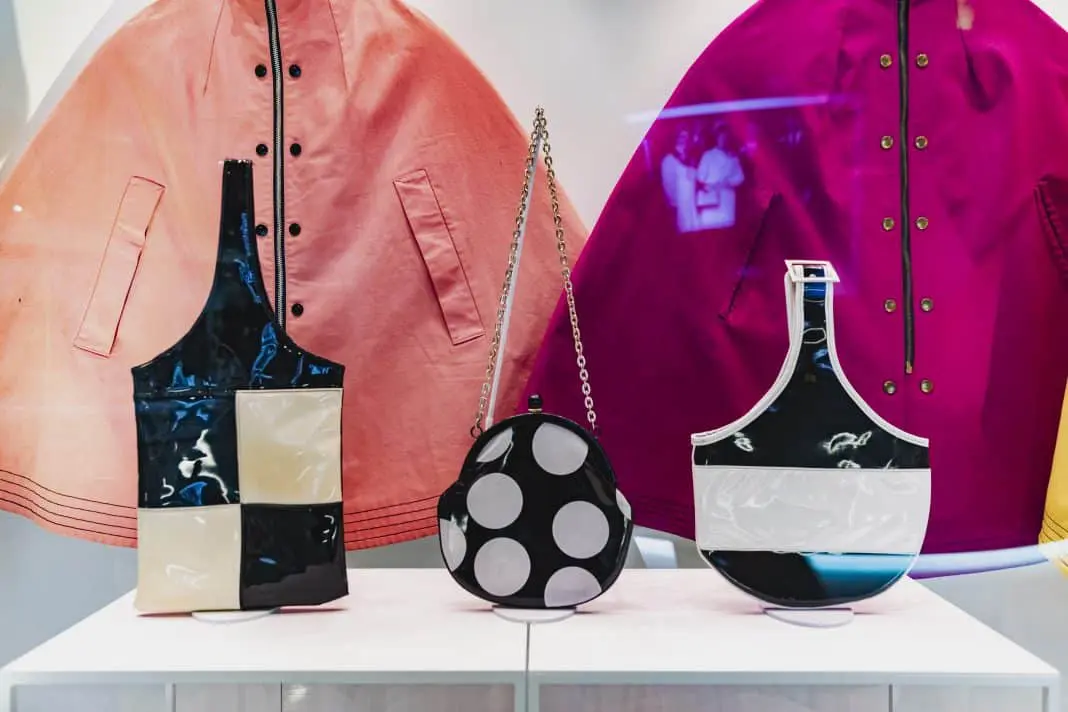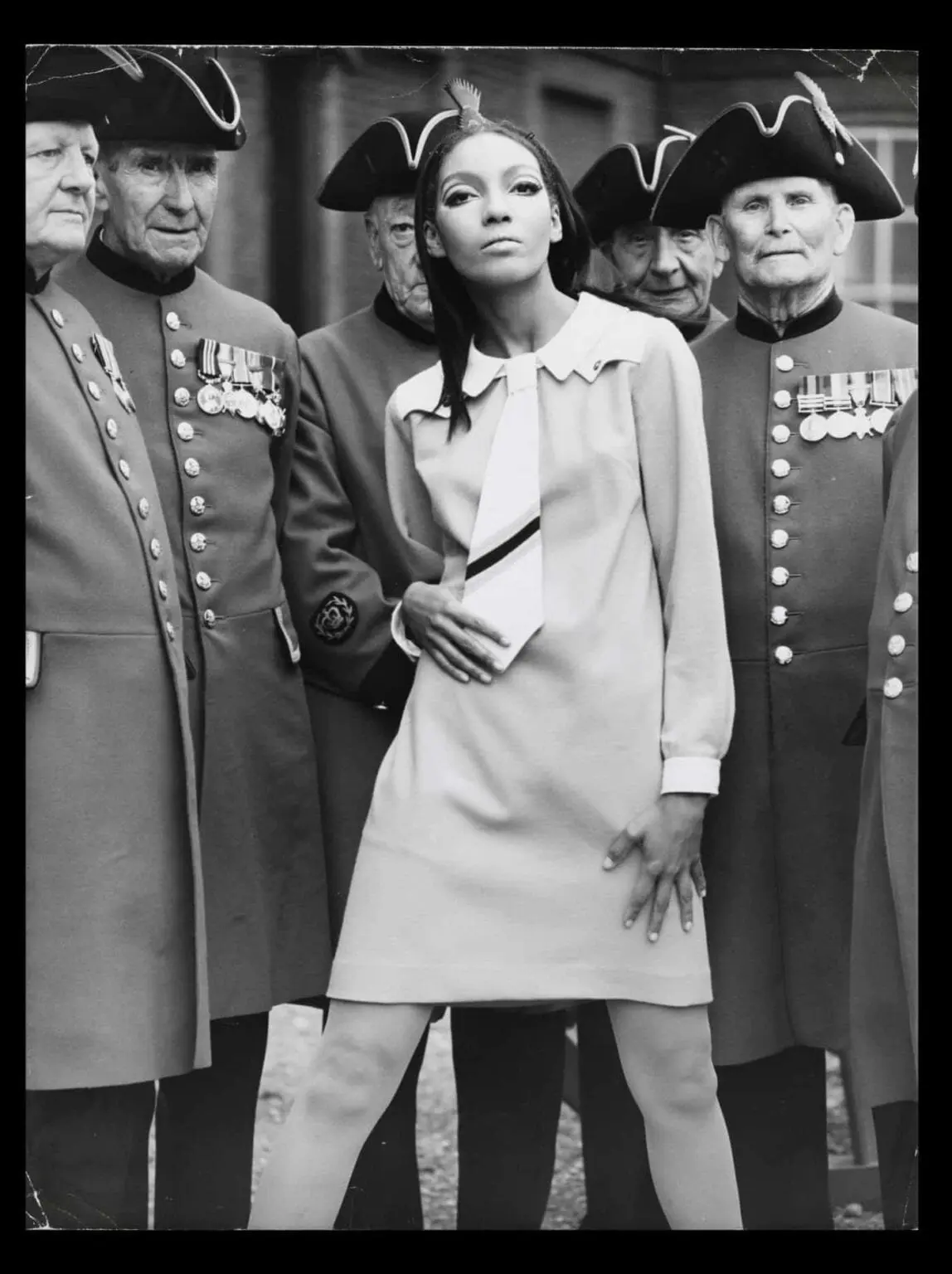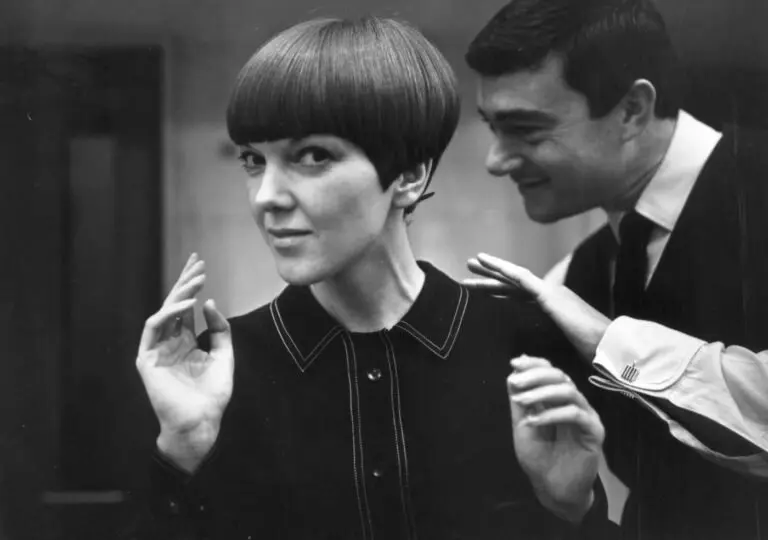
Mary Quant at the V&A
6th April – Feb 2020
“Fashion is not frivolous, it is part of being alive today” Mary Quant
Dame Mary Quant is a fashion icon, originating from the 1960s. Inventive, opinionated and commercially minded, Mary was a design and retail pioneer.
The Mary Quant exhibition sponsored by King’s Road is a spectacular retrospective look of her work from 1955-1975. Mary revolutionised the high street. She harnessed the youthful spirit of the sixties. She used the new mass-production techniques to create a new look for women. What’s more, she made fashion accessible, which was most important for the designer.
Quant became a powerful role model for the working woman. She popularised the mini-skirt. The mini-skirt became synonymous with her brand. It was integral to the development of the ‘Swinging Sixties’ scene.

Mary Quant – The Exhibition
The Mary Quant exhibition is an incredible collection of her garments worldwide. It brings together over 120 garments, accessories, and cosmetics. These items have never been shown before.
In June 2018, a call-out to the public to track down rare garments for the exhibition received over 1,000 responses. These changed the narrative of the exhibition. Sheila Hope came forth with her dress made for her 21st Birthday from a Butterick dress pattern. She described it as “an iconic, simple design which instantly appealed to me. It had a frilled neckline and sleeves with tiny darts to shape and ease the elbow”.
The beginning of the exhibition sets the scene of post-war London. It showcases the opening of her experimental shop, Bazaar, on Chelsea’s King’s Road in 1955. Mary inspired young women to rebel against traditional dress. She often based her designs on schoolgirl pinafore dresses or masculine tailoring. I am a personal fan of the multi-coloured PVC raincoats.

Mary Quant through the years
Born and brought up in Blackheath, London, Mary Quant was the daughter of two Welsh schoolteachers. After her parents’ refusal to let her attend a fashion course. Quant studied illustration at Goldsmiths, where she met her future husband, the aristocrat Alexander Plunket Greene. She graduated in 1953 with a diploma in art education. She then began an apprenticeship at a high-end milliner, Erik of Brook Street.
In 1955, Plunket Greene purchased Markham House on the King’s Road in Chelsea, London. An area frequented by the ‘Chelsea Set’. This group consisted of young artists, film directors, and socialites. They were interested in exploring new ways of living and dressing. Quant, Plunket Greene, and a friend, lawyer-turned-photographer Archie McNair, opened a restaurant (Alexander’s) in the basement of the new building. They also opened a boutique called Bazaar on the ground floor. The different strengths of each partner contributed to their long term success; while working together on all aspects. Quant concentrated on design. Plunket Greene had entrepreneurial and marketing skills. McNair brought legal and business sense to the brand.
Quant initially stocked the shop with outfits she sourced on the wholesale market. She exploited the opportunity to offer a new take on women’s style. But she soon became frustrated with the clothes available. Encouraged by the success of what Quant described as a pair of ‘mad’ lounge
Quant was a self-taught designer. She attended evening classes on cutting and adjusting mass-market printed patterns. This helped her achieve the looks she was after. Once technically proficient, she initiated a hand-to-mouth production cycle. The day’s sales at Bazaar paid for the cloth. It was then made up overnight into new stock for the next day. Although exhausting, this cottage-industry approach meant that the rails at Bazaar were continually refreshed with short runs of new designs. Satisfying the customers’ hunger for fresh, unique looks at competitive prices.
From the late 1950s to the early 1960s, Bazaar was one of the very few shops in London. It offered a choice to the ‘mature’ styles produced by other high-fashion designers. It also offered a radically different shopping experience. This was unlike the couturiers, department stores, and chain stores that made up the mainstream fashion market. At Bazaar, loud music and free drinks created a ‘scene.’ Witty window displays and extended opening hours kept it going late into the evening. Young women travelled to Bazaar to enjoy shopping for ‘something different’ in a much less formal environment.
Quant’s first collections were strikingly modern in their simplicity, and very wearable.
Quant’s developing aesthetic was influenced by the dancers, musicians and Beatnik street chic of the Chelsea Set. The Mods (short for ‘Modernists’) also influenced her. They helped to define London’s youth culture in late-1950s Britain. Their love of sharp tailoring and clean outlines was notable. Quant’s first collections were strikingly modern in their simplicity, and very wearable. Unlike the more structured clothes still popular with couturiers, Quant wanted “relaxed clothes suited to the actions of normal life”. Pairing short tunic dresses with tights in bright, stand-out colours – scarlet, ginger, prune and grape. She created a bold, high-fashion version of the practical outfits she’d worn as a child at school. She also created versions of those outfits for dance classes.
An interest in the unexpected was another signature for Quant.
One of her early designs from 1958 – a three-piece outfit in grey flannel – combines a hat. It also includes knickerbockers and a tunic-style shift. A striking ensemble that revisions Victorian undergarments as a quirky form of daywear. Other examples of Quant’s irreverent approach include her line of men’s cardigans long enough to wear as dresses. She also designed white plastic collars used to brighten up sweaters and dresses. Such designs easily allowed young consumers to buy into ‘

Extremely short skirts and shift dresses became Quant’s trademark
Quant is often credited with inventing the decade’s most iconic look: the mini-skirt. There is no conclusive evidence to say who first took hemlines a daringly long way north of the knee. Regardless, extremely short skirts and shift dresses became Quant’s trademark. Popularised by the era’s most high-profile model, Twiggy, whose willowy figure helped turn super-short hemlines into an international trend. Mini-skirts and dresses were perfectly paired with Quant’s tights and her underwear range. One of the first lines produced using the Mary Quant name under license. Quant also created the ‘skinny rib’. A sweater (apparently inspired by trying on an eight-year-old’s sweater for fun) and, in 1966 invented hot pants. Capitalising on the 1960s’ love affair with new materials. Mary was the first designer to use PVC, creating ‘wet look’ clothes. As well as different styles of weatherproof boots in her footwear range, Quant Afoot.
Quant cements her position as a commercial and cultural powerhouse
As London’s boutique scene was still blossoming, Quant was cementing her position as a commercial and cultural powerhouse. In 1962, she signed a lucrative design contract with American department-store chain JC Penney. In 1963 the company Mary Quant Limited expanded into the UK mass market. It introduced a new, cheaper diffusion line called Ginger Group. The same year, Quant was given The Sunday Times‘ International Award for “jolting England out a conventional attitude towards clothes”. In 1966, she was awarded an OBE and published her autobiography, ‘Quant by Quant’. The next year, she opened her third shop, in London’s New Bond Street.
By the end of the decade, Quant was the UK’s most high-profile designer. She had achieved unprecedented reach in the market. It was estimated that up to seven million women had at least one of her products in their wardrobe. While thousands more sported the super-modern shades of her ‘Daisy’-badged cosmetics range.

Quant remained at forefront of fashion
For the first half of the 1970s, Quant remained at the forefront of fashion. Her work was celebrated in a retrospective exhibition Mary Quant’s London. It was held at the London Museum (Kensington Palace) from November 1973 to June 1974.
From the late 70s onwards, the business produced high-quality womenswear. It also created interior designs for British manufacturing company ICI, including bed linen, carpets, paint, and wallpaper. The business also developed diffusion ranges. These include swimwear, hosiery, jewellery, the Daisy fashion doll, and popular makeup and skincare products. Quant introduced skincare for men and published books promoting her ideas about cosmetics.
In 1990 she was awarded the prestigious Hall of Fame Award by the British Fashion Council. The award recognised her outstanding contribution to British fashion. She published her second autobiography in 2012 and became a Dame in the 2015 New Year’s Honours list.
Quant’s iconic Daisy can be seen all around the exhibition
What I also find fascinating is that Mary Quant became a marketing dream and fashion powerhouse. The iconic Daisy can be seen all around the exhibition. Mary made fashion accessible and less exclusive, celebrating the modern woman.
Quant was the embodiment of her own label. Distinctive, playful and revolutionary. The show focuses on showcasing everything from Mary Quant. Even through to her own line of dolls, known as Daisy Dolls.
“Mary Quant transformed the fashion system, overturning the dominance of luxury couture from Paris. She dressed the liberated woman, freed from rules and regulations, and from dressing like their mothers. This long over-due exhibition shows how Mary Quant’s brand connected with her customers. How she made designer fashion affordable for working women, and how her youthful, revolutionary clothes, inspired by London’s creative scene, made British street style the global influence remains today” Jenny Lister, co-curator of Mary Quant at the V&A
From a small boutique on the King’s Road to a global fashion brand. Quant revolutionised British fashion with energy and flair.
Mary Quant at the V&A is an absolute must for anyone who loves fashion. It is also essential for anyone interested in a peek into one of Britain’s most revolutionary and iconic fashion icons.
All images: Credit Mary Quant. Sponsored by King’s Road. At the V&A from 6th April 2019 – 16 February 2020 vam.ac.uk/maryquant

Event Info:
Exhibition runs from 6 April – 16 February
Tickets £12
V&A Museum
Curated by Jenny Lister & Stephanie Wood

